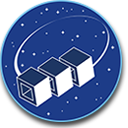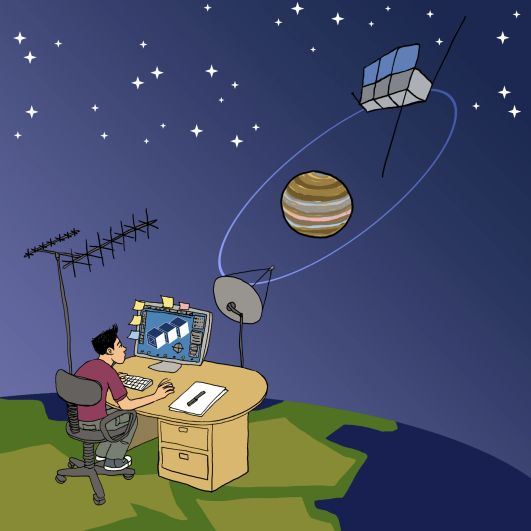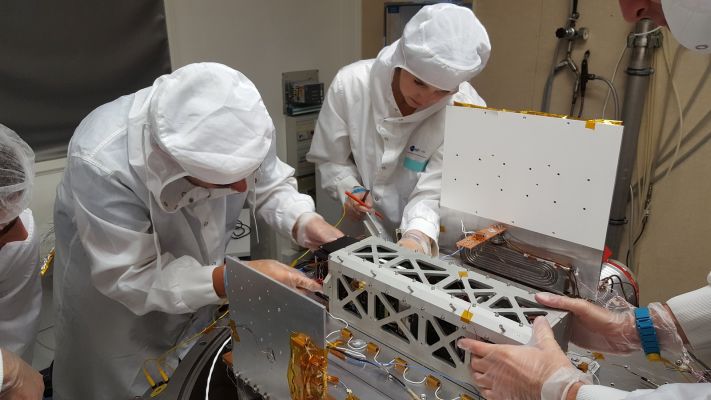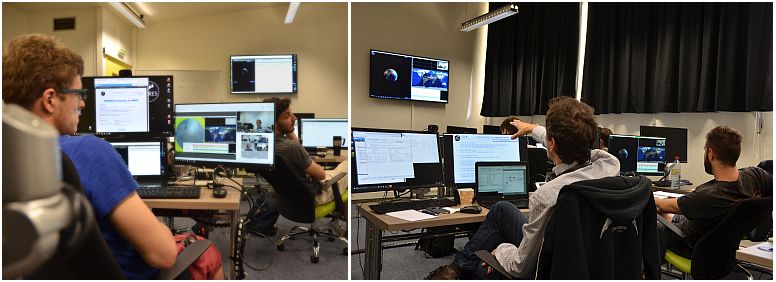Prototyping with DOCKS
 DOCKS is an aggregator of computational modules, 100% free and validated, to support the design of space mission profiles for nanosatellites. DOCKS is convenient in many contexts, including interplanetary cruise or proximity operations at a complex celestial body (a double asteroid for instance).
DOCKS is an aggregator of computational modules, 100% free and validated, to support the design of space mission profiles for nanosatellites. DOCKS is convenient in many contexts, including interplanetary cruise or proximity operations at a complex celestial body (a double asteroid for instance).
01/2022 Release: DOCKS modules will be sequentially released. The latest version (v6.1) of the DOCKS Propagator is available now**. Dowload from here.
The new versions of the modules EPS (v6.0.1) and Intervisibility (v2.0) are also online. Subscribe to the newsletter via the page footer to stay informed on new DOCKS releases.
Remote Service: A remote service for DOCKS is operational now. No hassle of downloading or installation, just drop your configuration files right away and get the outputs in no time. Read more about it here.

The features of DOCKS are summarized below. The installation procedure is provided in the README of respective modules to target Linux Ubuntu and MS-Windows platforms. The installation can also be done on a virtual machine (for instance a VirtualBox virtual machine in an MS-Windows, Linux or Mac computer). The user support is set up at this address: docks.contact (at) obspm.fr. DOCKS is developed in Python and should be compatible with all operating systems. However, it is only tested with Linux and Windows OS. Moreover, DOCKS will be issued to the open-source community under GPL. Libraries from various origins are included (*): Numpy, AstroPy, Poliastro, PyQuaternion, Quaternion, AstroQuery, pyKEP, Scipy and SpiceyPy.
DOCKS main features:
- mission profile generation to be displayed in VTS, the free "Visualization Tool for Space data" by CNES (French space agency) that also includes the famous CELESTIA free 3D engine
- launch of specialized modules (integrated or stand-alone) and production of corresponding VTS scenario
- all outputs are produced in CCSDS compliant format
- remote service is available for incompatible OS
Modules currently in DOCKS that will be issued sequentially:
- Deep Space Propagator: Generate a trajectory ephemeris in ICRS or True Ecliptic frame propagated from a set of initial conditions using RK4 method (constant time intervals) or by RKF45 method (intervals adapted to the curvatures of the trajectory). Include perturbations due to point masses, non-spherical bodies, solar radiation pressure and/or continuous thrust. The module also accepts (**) your own Complex Gravitational Models (CGM), e.g. to produce trajectories in the vicinity of non-spherical asteroids.
- CONIC: Generate an ephemeris of positions for a Keplerian orbit produced in plano-centric ICRS or another known frame (SSB-centric or Heliocentric, ICRS or true Ecliptic).
- Intervisibility: Generate an ephemeris on intervisibility with a terrestrial target (elevation on the horizon, eclipses) and propagation attenuation (excluding antenna and atmosphere gains).
- Electric Power System: Generate an onboard power ephemeris for a mission scenario with models of batteries, solar panels and system consumption.
- Datalink: Generate an ephemeris of on-board data volume based on primitive modelling with Intervisibilities and mode strategy of the mission.
- Quaternions: Generate an ephemeris of single quaternions for inertial pointing, uniform rotation or ground station tracking.
- ADCS: Convert an ephemeris of quaternions in a reference by a fixed rotation into a new reference, e.g. the field of view of an instrument. Coupling with continuous propulsion and based on standard control laws. Generate slew rates.
You can already take part in the development of DOCKS by testing and sending us your opinions: bug, suggestion, benchmark & tests. For experts, the code is open and you can offer us improvements.
(*) Contributors: we would like to thank the authors of the Numpy, AstroPy, Poliastro, PyQuaternion, Quaternion, Spiceypy, Scipy, AstroQuery python libraries, of Celestia, the authors of VTS and STELA at CNES, of pyKEP at ESA and in the partner laboratories, and NAIF for spice kernels. The direct contributors to DOCKS and its deep space Propagator are as follows to this day: Audrey Porquet, Hao-Chih Jim Lin, Thomas Gascard, Nima Traore, Zacharie Barrou-Dumont, Guillaume Thebault, Nicolas Bochard, Edouard Leicht, Florian Jousseaume, Gary Quinsac, Laëtitia Lebec, Claire Castell, Janis Dalbins, Thibault Delrieu, Sébastien Durand, development managed by Rashika Jain and Boris Segret.
(**) Progress of the deep space propagator: still partial validation. In some non-Keplerian (N-body) cases, unexplained drifts are observed over the medium term (several months). Warning: the use of CGM cannot be fully validated as it depends on the author of the CGM. The possible non-inertial frames are limited, SSB ICRS is preferred. A simplified model for solar radiation pressure is included. Finally, continuous thrust is included but not validated in complex scenarios.






